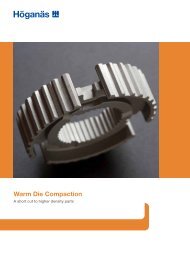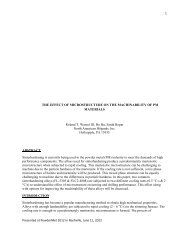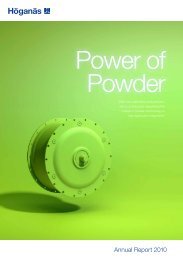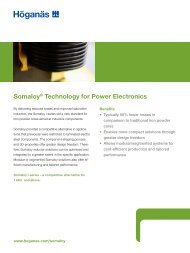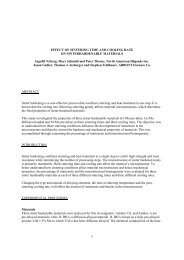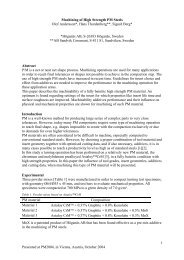high density pm components by high velocity ... - Höganäs AB
high density pm components by high velocity ... - Höganäs AB
high density pm components by high velocity ... - Höganäs AB
You also want an ePaper? Increase the reach of your titles
YUMPU automatically turns print PDFs into web optimized ePapers that Google loves.
II. IMPORTANCE OF DENSITY<br />
The importance of <strong>density</strong> on the properties of PM materials is paramount. See Figure 1. This study<br />
focuses on the potential growth achievable <strong>by</strong> improved mechanical properties and therefore only <strong>density</strong><br />
levels above 7.0 g/cm3 are of interest. Numerous references cover the importance of <strong>density</strong> in powder<br />
metallurgy. [11-14]<br />
The main reason why PM materials with the same structure as a corresponding wrought material show<br />
lower properties is the presence of pores that simply reduce the load-carrying area and increase the local<br />
stress in the material.<br />
However, for most of the properties, strengthening the matrix with well-designed metallurgy/structure can<br />
compensate for the porosity-related drop in performance.<br />
In the case of properties such as toughness and fatigue strength, pores can initiate cracks.<br />
The size and shape of the largest pores are examples of factors that limit fatigue performance.<br />
Properties , % of theoretical maximum<br />
100%<br />
80%<br />
60%<br />
40%<br />
20%<br />
Density g/cm3<br />
6.4 6.6 6.8 7.0 7.2 7.4 7.6 7.8<br />
Tensile strength<br />
Fatigue strength<br />
Elongation<br />
0%<br />
80% 85% 90% 95% 100%<br />
Relative Density<br />
Figure 1. Principal materials properties relation to <strong>density</strong> for sintered ferrous steel<br />
Materials-related factors that influence the fatigue performance are listed in Table 1.<br />
Traditionally the trend towards <strong>high</strong>-fatigue performance focuses on minimizing the porosity and<br />
optimizing the structure of the matrix. Other significant factors for fatigue performance are residual<br />
stresses and impurities (size and shape). Residual stress can be both positive and negative. If residual<br />
stresses increase total stress, they reduce fatigue performance.<br />
Table 1. Materials-related factors that influence fatigue performance<br />
• Porosity<br />
• Microstructure<br />
• Residual stresses<br />
• Impurities<br />
Residual stresses achieved intentionally <strong>by</strong> surface rolling, shot-peening or case-hardening generally<br />
improve fatigue performance considerably. Increasing efforts are being made in component design and<br />
subsequent processing, which lead to material improvements locally in the most loaded areas.<br />
Powder cleanliness with respect to impurities (i.e inclusions) in standard <strong>high</strong>-quality atomized powder<br />
materials is in most cases not considered a limiting factor, except for extreme applications subjected to<br />
very <strong>high</strong> load.<br />
2



